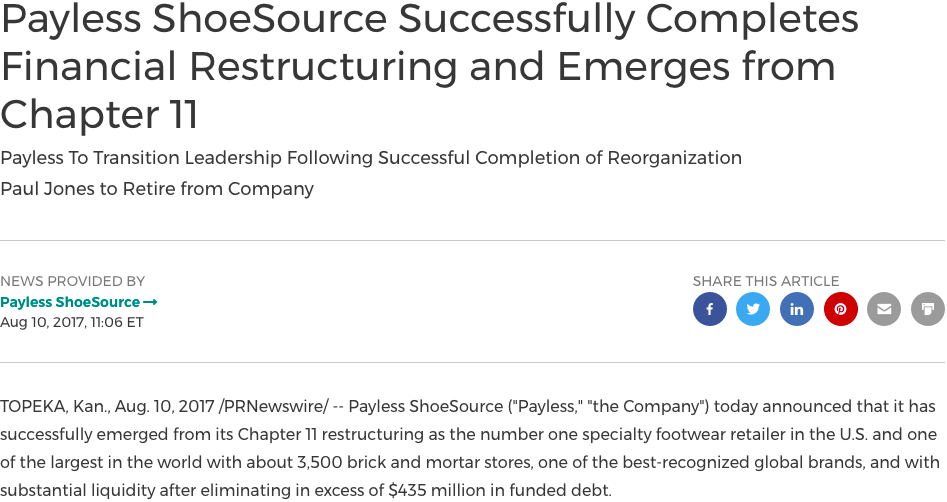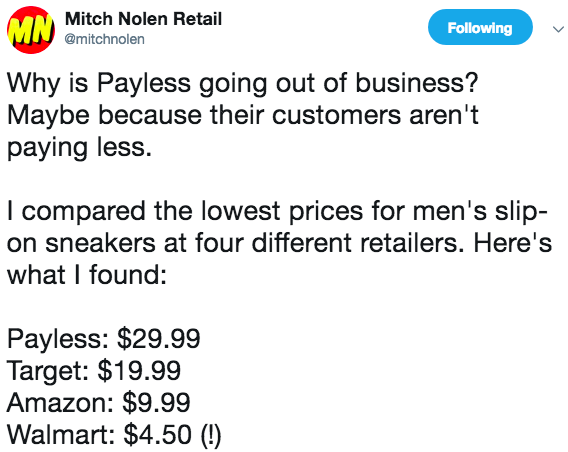Seriously. Give us whatever they’re smoking out in Topeka Kansas: sh*t must be lit. Literally.
So what did EBITDA actually come in at? Depending on which paragraph you read in the company’s First Day Declaration filed in support of the chapter 22 petition: negative $63mm or negative $66mm (it differs on different pages). For the mathematically challenged, that’s an ~$182mm delta. 🙈💩 “Outstanding leadership team,” huh? The numbers sure beg to differ.
This miss is SO large that it really begs the question: what the bloody hell transpired here? What is this dire performance attributable to? In its 2017 filing the company noted the following as major factors leading to its bankruptcy:
Since early 2015, the Debtors have experienced a top-line sales decline driven primarily by (a) a set of significant and detrimental non-recurring events, (b) foreign exchange rate volatility, and (c) challenging retail market conditions. These pressures led to the Debtors’ inability to both service their prepetition secured indebtedness and remain current with their trade obligations.
The company continued:
Specifically, a confluence of events in 2015 lowered Payless’ EBITDA by 34 percent—a level from which it has not fully recovered. In early 2015, the Debtors meaningfully over purchased inventory due to antiquated systems and processes (that have since undergone significant enhancement). Then, in February 2015, West Coast port strikes delayed the arrival of the Debtors’ products by several months, causing a major inventory flow disruption just before the important Easter selling period, leading to diminished sales. When delayed inventory arrived after that important selling period, the Debtors were saddled with a significant oversupply of spring seasonal inventory after the relevant seasonal peak, and were forced to sell merchandise at steep markdowns, which depressed margins and drained liquidity. Customers filled their closets with these deeply discounted products, which served to reduce demand; the reset of customer price expectations away from unsustainably high markdowns further depressed traffic in late 2015 and 2016. In total, millions of pairs of shoes were sold below cost in order to realign inventory and product mix. (emphasis added)
You’d think that, given these events, supply chain management would be at the top of the reorganized company’s list of things to fix. Curiously, in its latest First Day Declaration, the company says this about why it’s back in BK:
Upon emergence from the Prior Cases, the Debtors sought to capitalize on the deleveraging of their balance sheet with additional cost-reduction measures, including reviewing marketing expenses, downsizing their corporate office, reevaluating the budget for every department, and reducing their capital expenditures plan. Notwithstanding these measures, the Debtors have continued to experience a top-line sales decline driven primarily by inventory flow disruption during the 2017 holiday season, same store sales declines resulting in excess inventory, and challenging retail market conditions. (emphasis added).
Like, seriously? WTF. And it actually gets more ludicrous. In fact, the inventory story barely changed at all: the company might as well have cut and pasted from the Payless1 disclosure statement:
The Debtors also faced an oversupply of inventory in the fall of 2018 leading into the winter of 2019. As a result, the Debtors were forced to sell merchandise at steep markdowns, which depressed margins and drained liquidity. Customers filled their closets with these deeply discounted products, which served to reduce customer demand for new product. In total, millions of pairs of shoes were sold at below market prices in order to realign inventory and product mix. (emphasis added)
As if that wasn’t enough, the company also noted:
The delayed production caused a major inventory flow disruption during the 2017 Holiday season and a computer systems breakdown in the summer of 2018 significantly affected the back to school season, leading to diminished sales and same store sales declines.
Sheesh. Did the dog also eat the real strategy? Bloomberg writes:
The repeat bankruptcies are a sign the original restructuring may have been rushed through too quickly or didn’t do enough to solve the retailers’ industry-wide and company-specific problems.
And this quote, clearly, is dead on:
“One of the easiest ways to waste time and money in Chapter 11 is to use the process only to effect a change in ownership but not to take the time and protections afforded by the bankruptcy process to fix underlying operations,” Ted Gavin, a turnaround consultant and the president of the American Bankruptcy Institute, told Bloomberg Law.
This begs the question: what did the original bankruptcy ACTUALLY accomplish? Apparently, it accomplished this pretty looking chart:









